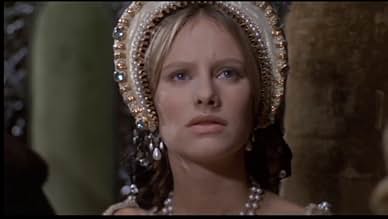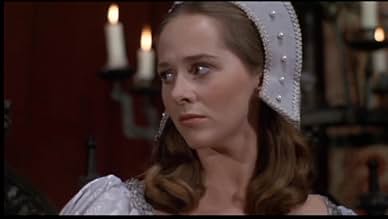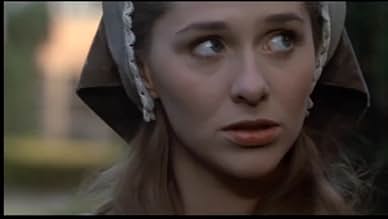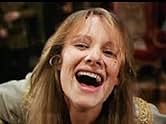In 1500s England, a cruel witch-hunting magistrate, who often tortures innocent villagers for his entertainment, runs afoul of a witch who conjures a banshee to kill the magistrate and his f... Read allIn 1500s England, a cruel witch-hunting magistrate, who often tortures innocent villagers for his entertainment, runs afoul of a witch who conjures a banshee to kill the magistrate and his family.In 1500s England, a cruel witch-hunting magistrate, who often tortures innocent villagers for his entertainment, runs afoul of a witch who conjures a banshee to kill the magistrate and his family.
Elisabeth Bergner
- Oona
- (as Elizabeth Bergner)
Hilary Heath
- Maureen Whitman
- (as Hilary Dwyer)
Victoria Fairbrother
- Margaret Donald - Witch
- (as Pamela Farbrother)
Storyline
Did you know
- TriviaCelebrated as the 100th film of Vincent Price's career. The cast attended a party to celebrate this, according to an interview with Sally Geeson given on Talking Pictures TV.
- GoofsOne of the characters sees a piebald rabbit, which turns into a gray rabbit when it is picked up. When it is returned to the ground and it runs away it has reverted to the original rabbit.
- Crazy creditsThe end credits are divided into "The Establishment, "Witches", and "Villagers".
- Alternate versionsThe original US release from AIP was a re edited and cut version. AIP created a new title sequence (dumping the Terry Gilliam animated titles) and removed some violence and nudity, as well as shuffling a few scenes around. This version was rated PG and was also released on VHS on the HBO / Thorn label as well as to TV in a version with even more cuts. In 1995, Orion released an EP speed VHS tape and went back to the original negative, releasing the original UK version, seen for the first time in the US. The DVD version is also uncut and has been rated R by the MPAA.
- ConnectionsFeatured in Deadly Earnest's Nightmare Theatre: Cry of the Banshee (1978)
Featured review
The film is set in Elizabethan England and revolves around a wicked magistrate who tries to kill all the members of a coven of witches. This makes the leader of the coven, Oona, sworn enemies of the lord and his family. To get revenge Oona calls up a magical servant, a "sidhe", to destroy the lord's family. The titular "cry of the banshee" is the signal that someone will die.
The script went through a few revisions. Tim Kelly's script had witches who were all old women and set the story in the 1700s. Christopher Wicking moved the time to the 1500s (more accurate) and made the witches varying ages and genders. Wicking also changed the wife to a stepmother rather than a mother of the Whitmans, which gives her a bit of distance to see the actions of her cruel new family.
Steve Haberman suggests that Wicking's re-write of Kelly was in part inspired by the Manson murders. The witches initially were more peaceful, but under Wicking actually invoke Satan by name. This takes the nature-worshiping cult to a whole new level... from nature to the devil himself. Director Gordon Hessler said he (and Wicking) wanted to get one more draft of the script in, but AIP was rushing the production. One wonders what might have happened with just a bit more spit and polish.
The first thing you will notice when watching this film is that it looks like the opening is from a Monty Python movie. And there is a good reason you think that: it was, in fact, animated by Terry Gilliam, the American member of Monty Python and their animator. Unfortunately, this may be the highlight of the movie.
Vincent Price carries this film, as there are no other big name actors to speak of. Unless you count AIP regular (and Academy Award winner) Hugh Griffith, who plays the drunken grave robber Mickey. Mike Mayo says Price is "not at his best" but "still fine", and that is a fair assessment. But even at just "fine", Price is more enjoyable to watch than most others of his generation.
The remainder of the cast, as I said, is hardly notable. There is Stephen Rea, who was later nominated for an Oscar, appearing in his first film role (he did a couple of television appearances before that). And there is a man named Guy Pierce in a very small role, but it is not the guy you think it is. A shame, really. Hilary Dwyer had previously been in both "Witchfinder General" (1968) and "The Oblong Box" (1969) alongside Vincent Price, but is not known outside of the AIP fan niche.
For some reason, there is a happy song sung by a man with a lute about a maiden who is raped by a huntsman, and then gets her revenge on him by castrating him. I do not know how to feel about this being sung as an uplifting ballad. Haberman says that this was a song that truly dated to the correct period, so I have to give them credit for that. And it does coincide with a maiden getting attacked by thuggish men... but no castration.
Overall, the film is okay or good, but not the best. Vincent Price has better films where he plays a witch hunter (including "Conqueror Worm") and better films in general. Still worth seeing, but do not put it at the top of your list. And do not try to find the banshee in this film, because one does not exist. Sorry.
Scream Factory, as always, has released the definitive version of this film on their Vincent Price box set. They give us both the AIP and unrated versions. So if you want to see a little extra violence, see a few more topless women, and hear the original score before AIP regular Les Baxter was hired to replace it, you now have that ability. Unfortunately, the director's cut does not substantially improve the movie's slow, poorly-conceived plot, and even director Gordon Hessler admits this is not some of his best work. (Amazingly, this was the biggest box office hit of the Hessler-Wicking team, even more than "Scream and Scream Again". Could it have been the misuse of the Poe name?)
Scream also provides a Steve Haberman audio commentary, which is very informative. He not only gives biographical information on the various people involved, but took the time to read both Kelly's and Wicking's scripts, so he knows quite well what went into developing the plot. The disc also has an archive interview with director Hessler, which is well worth checking out.
The script went through a few revisions. Tim Kelly's script had witches who were all old women and set the story in the 1700s. Christopher Wicking moved the time to the 1500s (more accurate) and made the witches varying ages and genders. Wicking also changed the wife to a stepmother rather than a mother of the Whitmans, which gives her a bit of distance to see the actions of her cruel new family.
Steve Haberman suggests that Wicking's re-write of Kelly was in part inspired by the Manson murders. The witches initially were more peaceful, but under Wicking actually invoke Satan by name. This takes the nature-worshiping cult to a whole new level... from nature to the devil himself. Director Gordon Hessler said he (and Wicking) wanted to get one more draft of the script in, but AIP was rushing the production. One wonders what might have happened with just a bit more spit and polish.
The first thing you will notice when watching this film is that it looks like the opening is from a Monty Python movie. And there is a good reason you think that: it was, in fact, animated by Terry Gilliam, the American member of Monty Python and their animator. Unfortunately, this may be the highlight of the movie.
Vincent Price carries this film, as there are no other big name actors to speak of. Unless you count AIP regular (and Academy Award winner) Hugh Griffith, who plays the drunken grave robber Mickey. Mike Mayo says Price is "not at his best" but "still fine", and that is a fair assessment. But even at just "fine", Price is more enjoyable to watch than most others of his generation.
The remainder of the cast, as I said, is hardly notable. There is Stephen Rea, who was later nominated for an Oscar, appearing in his first film role (he did a couple of television appearances before that). And there is a man named Guy Pierce in a very small role, but it is not the guy you think it is. A shame, really. Hilary Dwyer had previously been in both "Witchfinder General" (1968) and "The Oblong Box" (1969) alongside Vincent Price, but is not known outside of the AIP fan niche.
For some reason, there is a happy song sung by a man with a lute about a maiden who is raped by a huntsman, and then gets her revenge on him by castrating him. I do not know how to feel about this being sung as an uplifting ballad. Haberman says that this was a song that truly dated to the correct period, so I have to give them credit for that. And it does coincide with a maiden getting attacked by thuggish men... but no castration.
Overall, the film is okay or good, but not the best. Vincent Price has better films where he plays a witch hunter (including "Conqueror Worm") and better films in general. Still worth seeing, but do not put it at the top of your list. And do not try to find the banshee in this film, because one does not exist. Sorry.
Scream Factory, as always, has released the definitive version of this film on their Vincent Price box set. They give us both the AIP and unrated versions. So if you want to see a little extra violence, see a few more topless women, and hear the original score before AIP regular Les Baxter was hired to replace it, you now have that ability. Unfortunately, the director's cut does not substantially improve the movie's slow, poorly-conceived plot, and even director Gordon Hessler admits this is not some of his best work. (Amazingly, this was the biggest box office hit of the Hessler-Wicking team, even more than "Scream and Scream Again". Could it have been the misuse of the Poe name?)
Scream also provides a Steve Haberman audio commentary, which is very informative. He not only gives biographical information on the various people involved, but took the time to read both Kelly's and Wicking's scripts, so he knows quite well what went into developing the plot. The disc also has an archive interview with director Hessler, which is well worth checking out.
- How long is Cry of the Banshee?Powered by Alexa
Details
- Release date
- Countries of origin
- Language
- Also known as
- Der Todesschrei der Hexen
- Filming locations
- Grim's Dyke House, Old Redding, Harrow Weald, Middlesex, England, UK(The House of Whitman- exteriors and interiors)
- Production company
- See more company credits at IMDbPro
Box office
- Budget
- $500,000 (estimated)
- Runtime1 hour 31 minutes
- Color
- Aspect ratio
- 1.85 : 1
Contribute to this page
Suggest an edit or add missing content







































